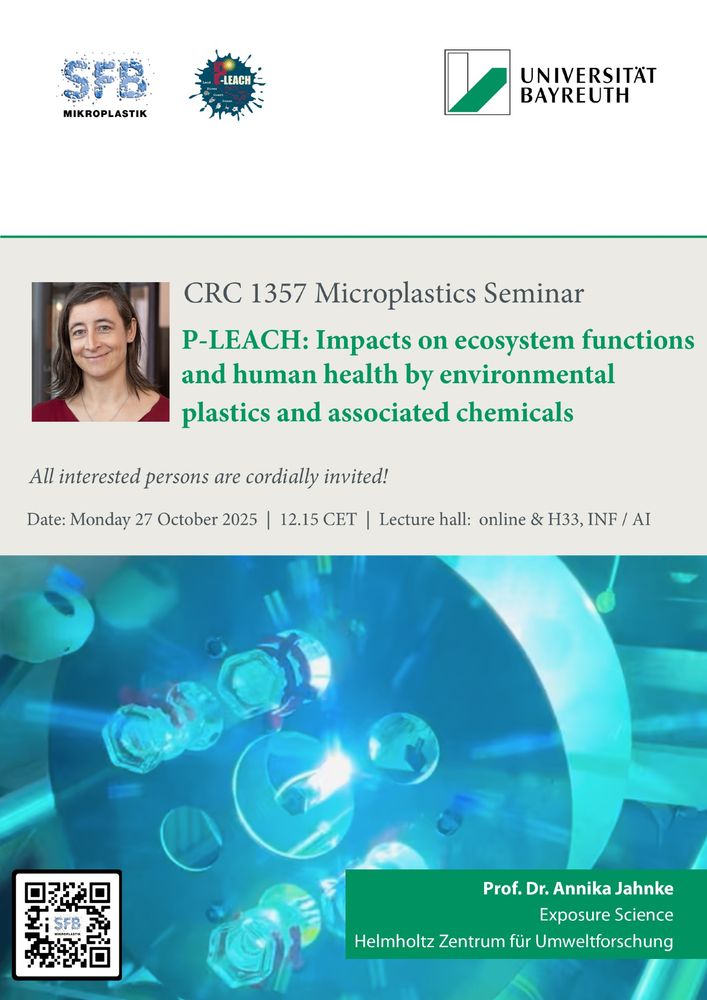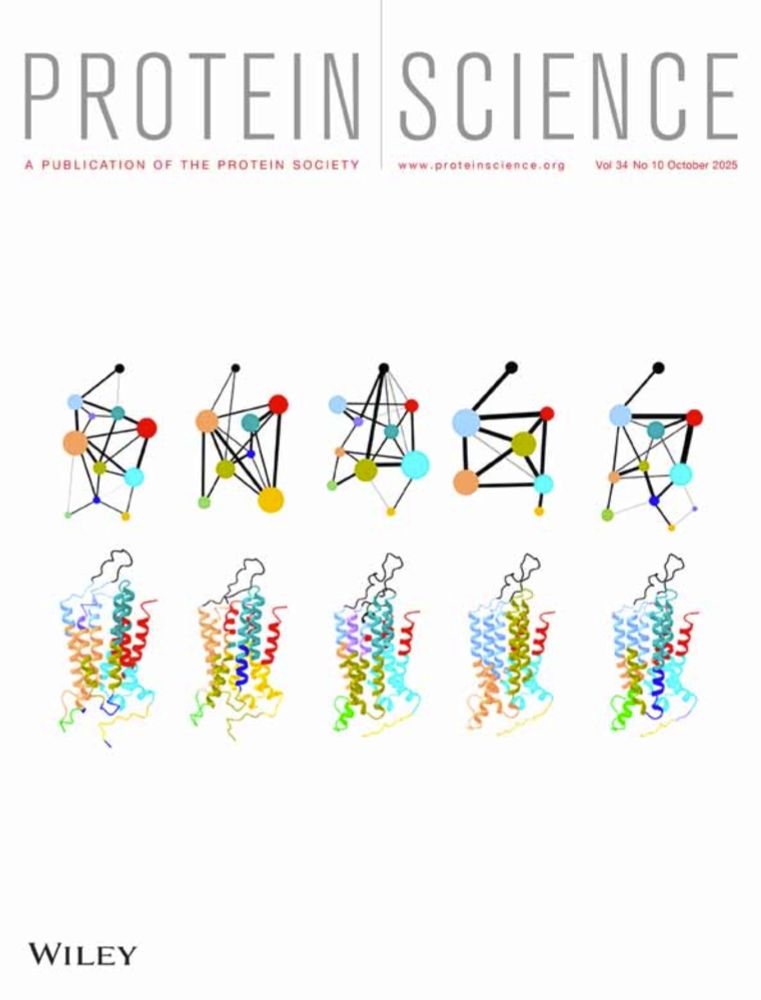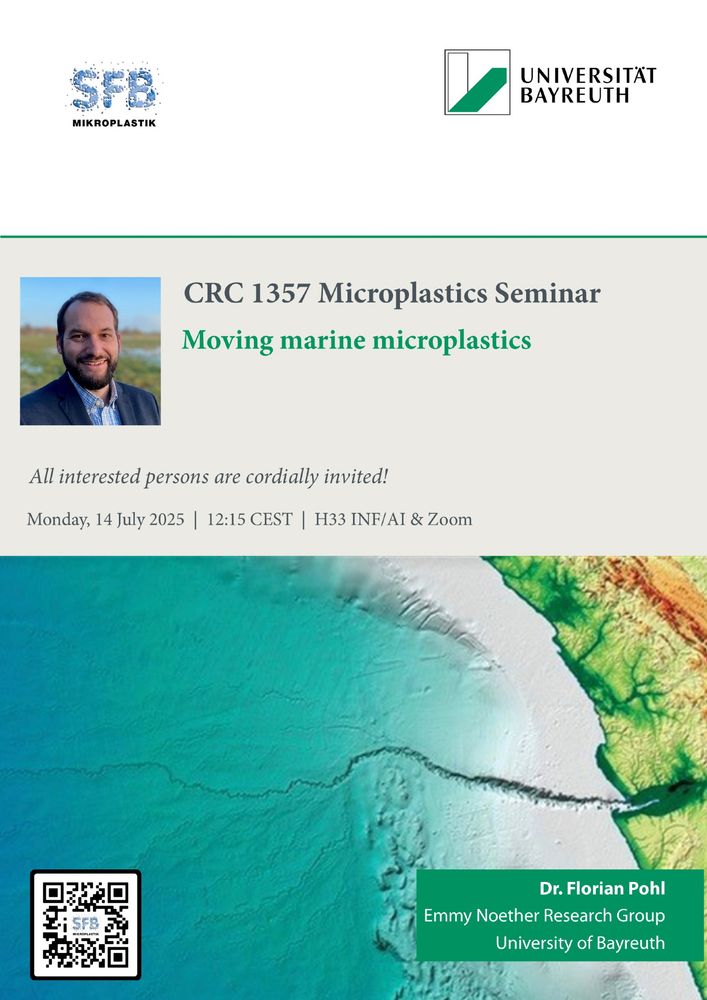
doi.org/10.1002/cssc...

doi.org/10.1002/cssc...
ubtaktuell.uni-bayreuth.de/umweltmedail...
#BayCEER #UniBayreuth #Ecology #Insects #Sustainability

ubtaktuell.uni-bayreuth.de/umweltmedail...
#BayCEER #UniBayreuth #Ecology #Insects #Sustainability
Congrats to Rizwan Khaleel & co-authors on their new in EnvironSystRes funded by @dfg.de and @daadworldwide.bsky.social
environmentalsystemsresearch.springeropen.com/articles/10....

Congrats to Rizwan Khaleel & co-authors on their new in EnvironSystRes funded by @dfg.de and @daadworldwide.bsky.social
environmentalsystemsresearch.springeropen.com/articles/10....

🎤 Prof. Dr. Annika Jahnke @ufz.de
P-Leach Impacts on ecosystem functions & human health by environmental plastics & associated chemicals
🗓 27.10.25
⏰ 12.15 CET
💻 Join on site or online
📩 Subscribe to our Newsletter for Zoom Links
Funded by @dfg.de

Joint work between @crc1357.bsky.social @unibayreuth.bsky.social and @ufz.de!
#Microplastics #CRCMP #WaterScience #Research #Modeling #KnowledgeExchange
Joint work between @crc1357.bsky.social @unibayreuth.bsky.social and @ufz.de!
#Microplastics #CRCMP #WaterScience #Research #Modeling #KnowledgeExchange
Die Veranstaltung am 10.09.25 bot Raum für Austausch: Warum sind Reformen nötig? Welche Chancen und Herausforderungen ergeben sich daraus? Und welchen Mehrwert bietet eine Mitgliedschaft in der internationalen CoARA – Coalition for Advancing #ResearchAssessment?

Die Veranstaltung am 10.09.25 bot Raum für Austausch: Warum sind Reformen nötig? Welche Chancen und Herausforderungen ergeben sich daraus? Und welchen Mehrwert bietet eine Mitgliedschaft in der internationalen CoARA – Coalition for Advancing #ResearchAssessment?
➡️ www.dfg.de/en/research-...

The open-source Toxicity of Microplastics Explorer received a major expansion. Congrats to all authors that contributed to this international coop led by Leah Thornton Hampton.
🔎 microplastics.springeropen.com/articles/10....

The open-source Toxicity of Microplastics Explorer received a major expansion. Congrats to all authors that contributed to this international coop led by Leah Thornton Hampton.
🔎 microplastics.springeropen.com/articles/10....
Great work!!
#Microplastics #Ecotoxicology #BayCEER
by @analeticiav.bsky.social , Luca Liprandi, Christian Laforsch and @magdalenammair.bsky.social.
academic.oup.com/etc/advance-...

Great work!!
#Microplastics #Ecotoxicology #BayCEER
by @analeticiav.bsky.social , Luca Liprandi, Christian Laforsch and @magdalenammair.bsky.social.
academic.oup.com/etc/advance-...

by @analeticiav.bsky.social , Luca Liprandi, Christian Laforsch and @magdalenammair.bsky.social.
academic.oup.com/etc/advance-...
Congrats to this interdisciplilnary study including 5 project teams @unibayreuth.bsky.social!
doi.org/10.1002/cmtd...
Congrats to this interdisciplilnary study including 5 project teams @unibayreuth.bsky.social!
doi.org/10.1002/cmtd...
www.youtube.com/watch?v=f3WO...

www.youtube.com/watch?v=f3WO...
is seeking a visionary and compassionate leader to serve as Executive Director of their laboratory. Truly an incredible opportunity to work with some of the world's leading researchers on #microplastics!
Apply by October 31st! <- lnkd.in/g2u_pJxs

is seeking a visionary and compassionate leader to serve as Executive Director of their laboratory. Truly an incredible opportunity to work with some of the world's leading researchers on #microplastics!
Apply by October 31st! <- lnkd.in/g2u_pJxs
doi.org/10.1016/j.bp...
#microplastics #celltransport #dynein
doi.org/10.1016/j.bp...
#microplastics #celltransport #dynein
Infos und Meeting-Link: https://sohub.io/xx7s

Infos und Meeting-Link: https://sohub.io/xx7s
Emerging challenges of microplastic impacts to ecological health and climate change
#Microplastics
#GreenhouseGasEmissions
#Ecologicalrisk
#ClimateChange
#Carboncycling
#Plasticpollution

Emerging challenges of microplastic impacts to ecological health and climate change
#Microplastics
#GreenhouseGasEmissions
#Ecologicalrisk
#ClimateChange
#Carboncycling
#Plasticpollution
Structure & sequence features of type III PETases reported!
onlinelibrary.wiley.com/doi/10.1002/...

Structure & sequence features of type III PETases reported!
onlinelibrary.wiley.com/doi/10.1002/...
Der Artikel von Falk Osterloh im Deutschen Ärzteblatt beleuchtet die weltweiten Folgen der Plastikverschmutzung auf Umwelt & Gesundheit sowie Lösungsansätzen. Interviewpartner: Christian Laforsch👍
Zum Artikel:
www.aerzteblatt.de/archiv/plast...

Der Artikel von Falk Osterloh im Deutschen Ärzteblatt beleuchtet die weltweiten Folgen der Plastikverschmutzung auf Umwelt & Gesundheit sowie Lösungsansätzen. Interviewpartner: Christian Laforsch👍
Zum Artikel:
www.aerzteblatt.de/archiv/plast...
A good moment to highlight our CRC 1357 Microplastics community zenodo.org/communities/...
A good moment to highlight our CRC 1357 Microplastics community zenodo.org/communities/...
www.mdpi.com/3483718
#compost #biodegradation #PLA #PBAT #crystallinity #microplastics
www.mdpi.com/3483718
#compost #biodegradation #PLA #PBAT #crystallinity #microplastics
@springer.springernature.com by our former master student
@paulineseidel.bsky.social: Vertical distribution & post-depositional translocation of microplastics in a Rhine floodplain soil
📖👉 microplastics.springeropen.com/articles/10....

@springer.springernature.com by our former master student
@paulineseidel.bsky.social: Vertical distribution & post-depositional translocation of microplastics in a Rhine floodplain soil
📖👉 microplastics.springeropen.com/articles/10....
My road to the 1st paper:
2022: Lab work done 🥼
2023: First draft 📑
2024: Final draft & first journal submission ✔️
2025: Two other journals later: Publication! 💥
Huge thanks to my co-others! Science is team-work 💪🏼
➡️ rdcu.be/eAFhd
My road to the 1st paper:
2022: Lab work done 🥼
2023: First draft 📑
2024: Final draft & first journal submission ✔️
2025: Two other journals later: Publication! 💥
Huge thanks to my co-others! Science is team-work 💪🏼
➡️ rdcu.be/eAFhd
Students & colleagues from all disciplines are welcome!

Students & colleagues from all disciplines are welcome!

